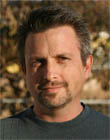|
|
This topic comprises 7 pages: 1 2 3 4 5 6 7
|
|
Author
|
Topic: Switch from common width to common height - trend or aberation?
|
|
|
|
|
|
|
|
|
|
|
|
|
|
|
Scott Norwood
Film God

Posts: 8146
From: Boston, MA. USA (1774.21 miles northeast of Dallas)
Registered: Jun 99
|
 posted 08-08-2007 09:45 AM
posted 08-08-2007 09:45 AM





For any theatre built after about 1960, there is really no excuse for common-width screens. In older theatres where the procenium was built with a 1.33 or so screen in mind, common-width may be the only option for getting an acceptibly large image for the narrower formats.
Personally, I hate common-width, since it usually requires re-framing when changing formats and also (as Brad mentioned) makes the non-scope formats look really bad due to the increased magnification. I actually know of one venue that is common-width for 1.33 through scope. The Academy image looks like Imax in that room, while the scope image is way too small. When the 16mm image is bigger than the 35mm scope image, something is wrong.
Actually, my preferred masking scheme is common-height for 1.66, 1.85, and scope, and gets slightly taller for 1.33 and 70mm.
| IP: Logged
|
|
|
|
|
|
|
|
Bobby Henderson
"Ask me about Trajan."

Posts: 10973
From: Lawton, OK, USA
Registered: Apr 2001
|
 posted 08-08-2007 02:28 PM
posted 08-08-2007 02:28 PM




quote: David Zylstra
But . . . . . Fixed width is not stupid, it's a business decision by the exhibitor driven by wanting to maximize picture size for each format and thereby impressing the customer base with the huge pictures.
Fixed width is indeed stupid. That brings up my favorite phase on the subject: "Driving Miss Daisy should not be bigger than Die Hard.
I understand it is a business decision on the part of exhibitors. Still, it is a business decision that makes absolutely no sense at all. They're assuming most major studio releases are 1.85:1. That was true back in the 1980s. These days, the vast majority of major studio releases are 'scope. There's plenty of weeks where the Carmike 8 in my town is playing nothing but 'scope films. And this is a trend that is already a few years old.
Flat releases seem pretty rare unless you're looking at indie product. And even there many small studio features are shot in 'scope as well. Hell, you even get cropped-to-'scope dimensions for shoestring budget movies shot on mere DV.
Basically, there's no excuse at all for common width screens.
Carmike's Sikes Ten theater in Wichita Falls, TX has some examples of the worst in common width screen design. A disclaimer, Carmike didn't built this theater (I think Plitt built it in the late 1970s). Carmike added 4 more screens in the late 1990s. Anyway, the six original small houses have these fixed 1.85:1 screens with the emergency exit door to the left or right of the screen. These screens have no move-able masking at all. When the theater was showing movies on film, any 'scope image would fall off the left or right end of the screen. It was like a really bad form of pan and scan. I don't know how they've changed things since doing the d-cinema conversion months ago. But the only other solution I can see is just letterboxing that 'scope image to fit in the already small-ish screen. It sucks, but it's better than the method previously used. At least you see the whole image. Carmike really just needs to build a new theater in Wichita Falls outside of Sikes Senter Mall and far enough away from Cinemark's new theater so they can break that allocation flip flop crap between studio releases.
| IP: Logged
|
|
|
|
Thomas Pitt
Master Film Handler

Posts: 266
From: Leeds, West Yorkshire, UK
Registered: May 2007
|
 posted 08-08-2007 03:44 PM
posted 08-08-2007 03:44 PM




The Vue Leeds Light, as I'm sure I mentioned in other posts, has fixed-width screens for all its auditoriums. For scope, a single blind drops from the top (top masking) to make the screen the correct aspect ratio.
I've never once seen the picture need to be re-framed after a scope changeover; I assume they have the turret set to project the scope image slightly lower - possibly with one of those adapters.
I also remember going to see a movie in Vue Sheffield, and they actually had both vertical and horizontal masking (4 blinds)! For scope, the top and bottom blinds move in a little bit, while the left and right blinds open up to full width. I think this is only in the large auditoriums though - the smaller auditoriums in Vue Sheffield use either top & bottom or side masking.
Vue Sheffield also have curtains in each auditorium that can cover the screen, but they're seldom - if ever - used.
With regards to luminance difference between flat and scope features, there certainly isn't any noticeable gain in brightness when a feature switches over to scope. Perhaps if you had a light meter, or could switch over lenses in mid-feature without dropping the douser, you might notice it. I've heard that some lamphouses actually have a kind of douser that comes down in front of the lamp and limits the amount of light. This can be used to 'dim' the light for scope features, so that they're the same brightness as flat features. Anyone had experience of this?
| IP: Logged
|
|
|
|
|
|
All times are Central (GMT -6:00)
|
This topic comprises 7 pages: 1 2 3 4 5 6 7
|
Powered by Infopop Corporation
UBB.classicTM
6.3.1.2
The Film-Tech Forums are designed for various members related to the cinema industry to express their opinions, viewpoints and testimonials on various products, services and events based upon speculation, personal knowledge and factual information through use, therefore all views represented here allow no liability upon the publishers of this web site and the owners of said views assume no liability for any ill will resulting from these postings. The posts made here are for educational as well as entertainment purposes and as such anyone viewing this portion of the website must accept these views as statements of the author of that opinion
and agrees to release the authors from any and all liability.
|

 Home
Home
 Products
Products
 Store
Store
 Forum
Forum
 Warehouse
Warehouse
 Contact Us
Contact Us




 Printer-friendly view of this topic
Printer-friendly view of this topic









![[thumbsup]](graemlins/thumbsup.gif)











